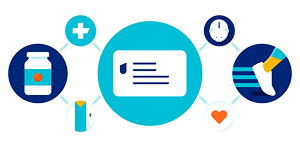If you’re looking to take your workout up a notch, consider high-intensity interval training (HIIT). What exactly is HIIT? These workouts alternate short bursts of vigorous aerobic exercise with brief periods of active recovery.
People of all ages and fitness levels can benefit from adding HIIT to their workout routine, says Ben Fung, P.T., D.P.T., M.B.A. Fung is a spokesperson for the American Physical Therapy Association.
The intensity and techniques used in HIIT workouts can be tailored to an individual’s fitness level. They can also be tailored to a person’s health circumstances, says Fung. “I’ve worked with retirees who recently had joint replacement surgery and are going through physical therapy,” he says. “I’ve also worked with younger adults who want to lose weight and increase strength.”
Even though anybody can do HIIT — and it’s tailorable, based on your fitness level — it can be a lot. “With HIIT, you’re aiming for a level of exertion where you can only talk for a few words at a time,” Fung says. “Most people who try HIIT for the first time have no idea how winded they’re going to be.”
Below, learn about how HIIT might be a good way to take your exercise (and health) regimen to the next level.
Need a health insurance plan? Explore your policy options now, or contact a licensed insurance agent at 1-844-211-7730.
What is HIIT?
With HIIT workouts, you’ll alternate short bursts of high-intensity movement that increase your heart rate with periods of quick recovery. These bursts of activity can last anywhere from 15 seconds to 4 minutes.
You’re meant to repeat these work-rest cycles several times, too. You may burn more calories and fat with HIIT in less time than with other workouts. These workouts may also help you build muscle.
Mention HIIT and many people envision a professional athlete doing burpees, box jumps and other aggressive workout moves. But HIIT can also involve running (or doing) short bursts on a treadmill (or stationary bike). It can also involve short bursts of jumping rope or brisk walking.
“There are a variety of HIIT workouts for different experience levels,” Fung says. For those who have never done HIIT, Fung recommends starting slow. You may want to work with a physical therapist or personal trainer to ensure proper form.
“To avoid injuries and burnout, it’s important to pace yourself,” says Fung. “Also, don’t start out using equipment that’s too heavy. And don’t try to do too much, too soon.” You could get hurt that way.
Learn more about available health plans today, or call a licensed insurance agent at 1-844-211-7730 to discuss your health insurance options.
The 4 health benefits of HIIT
Many studies have shown that HIIT can boost overall health in numerous ways. Here are 4 of them:
Health benefit #1. HIIT may help your heart stay healthy. A review of 97 medical trials found that HIIT workouts may boost heart function. The researchers found that HIIIT produced improvement in 14 heart health measurements, including peak aerobic capacity and resting heart rate. It was also shown to reduce body mass index and waist circumference.
Health benefit #2. HIIT may boost your bone density. “There’s quite a body of evidence showing that HIIT can benefit women with osteopenia and osteoporosis,” says Fung. HIIT may be effective for improving, or at least maintaining, bone density in the lumbar spine and femur in postmenopausal women. The high impact and muscle compression force produced from HIIT exercises may slow the process of bone aging, too. And it may contribute to better functionality overall.
Health benefit #3. HIIT may improve your ability to control your blood sugar. HIIT may be effective in helping you control the levels of blood sugar (glucose) in your body. A review in Frontiers in Endocrinology found that people with diabetes who did HIIT exercises 3 times per week for 12 weeks had lower fasting blood glucose levels and lower A1c levels. Bonus: They also lowered their cholesterol levels.
Health benefit #4. HIIT may help lower your blood pressure. Incorporating HIIT into your workout is also a great way to lower blood pressure, says Fung. One review of 36 studies found that HIIT lowers blood pressure as effectively as longer sessions of low- to moderate-intensity aerobic exercise. High blood pressure may lead to kidney disease, heart disease and stroke.
While HIIT can be a great exercise option for many people, if you have heart or blood pressure issues you’ll want to check with your doctor or specialist before beginning, says Fung. That’s because these workouts place big demands on the heart.
How can health insurance help with HIIT?
“If you have health insurance, ask your doctor for a referral to a physical therapist,” Fung says. Some health plans may allow you to self-refer to a physical therapist. You may have to pay a copayment.
Fung notes that HIIT can be considered part of therapeutic exercise as prescribed for patients by a physical therapist. This is particularly true for those recovering from joint replacement surgery, shoulder impingement or other injuries.
If a physical therapist isn’t an option, see if your health plan covers the cost of a gym membership (or you can just buy your own monthly gym membership). If so, consider scheduling a few introductory sessions with a personal trainer. They can assist you in developing a safe HIIT workout.
“I advise most people to gradually begin a HIIT workout,” says Fung. “If you’re completely sedentary, once a week might be enough for the first couple of weeks. You’ll probably feel sore for a couple of days after each workout.”
Once your body starts adjusting to your new workout regimen, then you up the frequency, adds Fung. For example, that could mean leveling up from 15 to 20 minutes per session once or twice a week to 2 to 3 times per week. “The whole concept of HIIT is being able to break up your workouts into manageable chunks of exercise,” he says. “You want to feel good about doing them on a consistent basis.”
Have further questions about available health plans? Browse available plans now, or call a licensed insurance agent at 1-844-211-7730 to discuss your options.
For informational purposes only. This information is compiled by UnitedHealthcare and does not diagnose problems or recommend specific treatment. Services and medical technologies referenced herein may not be covered under your plan. Please consult directly with your primary care physician if you need medical advice.
Sources:
Cureus. “Effects of aerobic exercise versus high-intensity interval training on V̇O2max and blood pressure.” October 2022. Retrieved from https://www.ncbi.nlm.nih.gov/pmc/articles/PMC9661924/
Cureus. “The role of high-intensity and high-impact exercises in improving bone health in post-menopausal women: a systemic review.” February 2023. Retrieved from https://www.ncbi.nlm.nih.gov/pmc/articles/PMC9990535/
Frontiers in Endocrinology. “The effect of low volume high-intensity interval training on metabolic and cardiorespiratory outcomes in patients with type 2 diabetes mellitus: a systematic review and meta-analysis.” January 2023. Retrieved from https://www.ncbi.nlm.nih.gov/pmc/articles/PMC9845913/
National Library of Medicine: MedlinePlus. “High blood pressure in adults — hypertension.” January 1, 2023. Retrieved from https://medlineplus.gov/ency/article/000468.htm
Sports Medicine. “High-intensity interval training and cardiometabolic health in the general population: a systematic review and meta-analysis of randomised controlled trials.” May 2023. Retrieved from https://pubmed.ncbi.nlm.nih.gov/37204620/
UC Davis Health. “High-intensity workouts can help you get fit fast, but preparation is key.” September 28, 2022. Retrieved from https://health.ucdavis.edu/blog/cultivating-health/high-intensity-workouts-can-help-you-get-fit-fast-but-preparation-is-key/2022/09
Compliance code:
50828-X-0524










